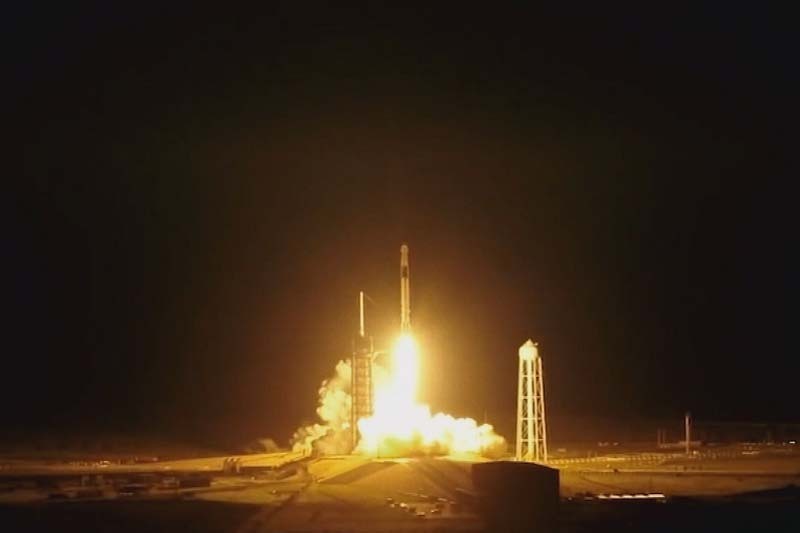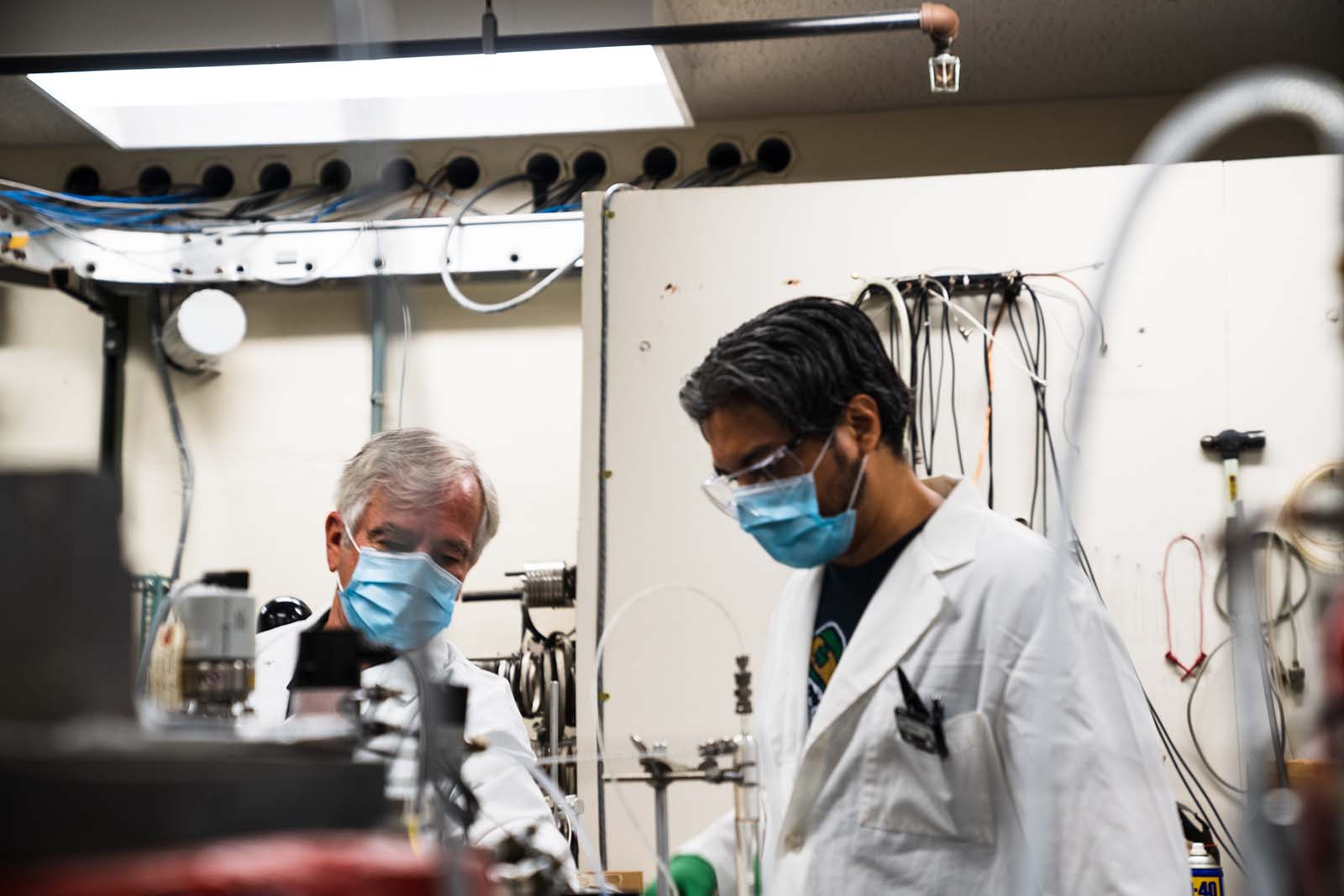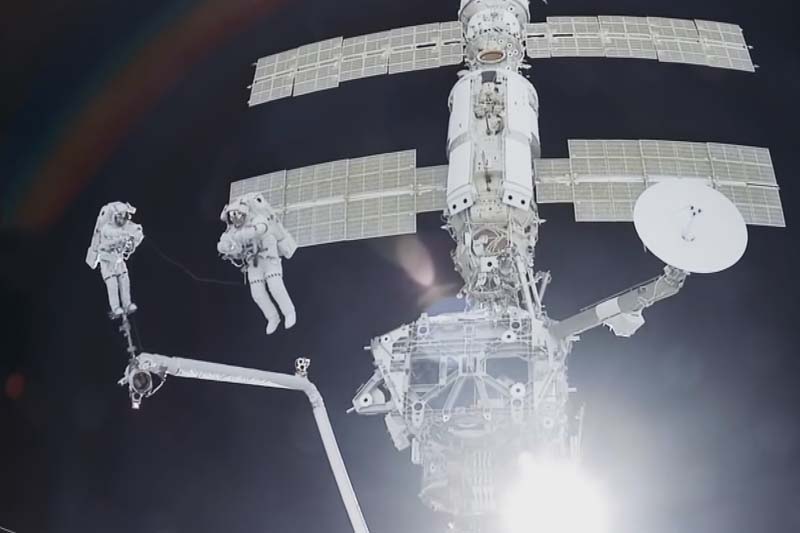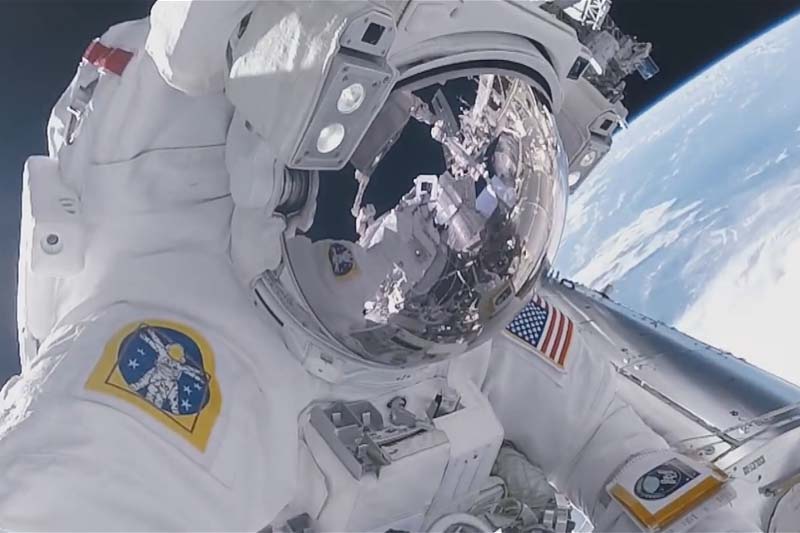Fighting to Reach the Next Frontier in Space

In May 2020, the world crowded around screens to watch the SpaceX demo flight of the Crew Dragon to the International Space Station. For a brief moment, the awe and wonder, the possibility and potential, was reminiscent of the Apollo missions and the first live coverage of splashdown more than 50 years ago. With the launch of the United States Space Force and NASA’s planned Artemis missions to the Moon, our nation may be reigniting its curiosity with what’s beyond. But years of slowed activity has its disadvantages, one of which includes outdated equipment and the spacesuits that keep astronauts safe.
Notre Dame physics professor Jay LaVerne is working with a multi-university team to design the next generation of materials allowing astronauts to safely explore deeper in space. The project is led by Thomas Orlando, a chemistry professor at Georgia Tech, and also includes Stephen Robinson, a former astronaut and now a professor of mechanical and aerospace engineering at the University of California, Davis. The project is part of the Radiation Effects on Volatiles and Exploration of Asteroids and Surfaces Center of the NASA Solar System Exploration Research Virtual Institute (SSERVI).
 Notre Dame physics professor Jay LaVerne (left) is working with a multi-university team to design the next generation of materials allowing astronauts to safely explore deeper in space.
Notre Dame physics professor Jay LaVerne (left) is working with a multi-university team to design the next generation of materials allowing astronauts to safely explore deeper in space.The three universities are working together on a multi-part project, LaVerne explains. First, it’s designing new polymers to create lighter, less cumbersome and more radiation-resistant space suits. Second, it’s creating monitors that can attach to the spacesuit and notify astronauts of temperature, radiation and oxygen levels — much like the mounted helmet cueing systems fighter pilots wear.
“I saw this as one aspect where I can actually do something and it has an immediate effect on someone.”
The team’s range of expertise is key. While Orlando has long worked with NASA and Robinson has firsthand experience in space, LaVerne was chosen because he is one of the world’s radiation experts, says Orlando. LaVerne notes he previously had little experience with outer space — his typical research looks at nuclear reactors, how to clean up nuclear waste, and radiation in medical applications — but this partnership offered a rare opportunity.
“As a chemist and a physicist, it's kind of hard to see your work being used. And I saw this as one aspect where I can actually do something and it has an immediate effect on someone,” LaVerne says.
He explains that radiation is one of the biggest issues astronauts face once they leave the Earth’s atmosphere. The Apollo moon walks or trips to the International Space Station have traditionally been short enough to allow for mitigation of those risks, but as humans start to spend longer durations on the moon, or venture to Mars — a 16-month process at least — their radiation exposure increases dramatically. Everything from the suits the astronauts wear, to the habitats they build, to the way their medications will work in space will be influenced by radiation, so LaVerne’s participation is key, says Orlando.
 As humans start to spend longer durations on the moon, or venture to Mars — a 16-month process at least — their radiation exposure increases dramatically. Photo courtesy of NASA.
As humans start to spend longer durations on the moon, or venture to Mars — a 16-month process at least — their radiation exposure increases dramatically. Photo courtesy of NASA.
 Everything from the suits the astronauts wear, to the habitats they build, to the way their medications will work in space will be influenced by radiation. Photo courtesy of NASA.
Everything from the suits the astronauts wear, to the habitats they build, to the way their medications will work in space will be influenced by radiation. Photo courtesy of NASA.
“When I decided that we needed to chase the radiation effects project problem, I immediately thought of Jay because I know Jay’s capabilities intellectually and what the capabilities at Notre Dame are,” Orlando says.
Notre Dame’s expertise in radiation dates back to World War II. When the Manhattan Project was underway, Notre Dame’s high-energy ion accelerator, then located in LaFortune Student Center, was used for experiments. Notre Dame faculty including Henry Bolger, Bernard Cullity and Bernard Waldman were contributors to the research. Since then, Notre Dame’s Radiation Laboratory has maintained an internationally prestigious reputation, thanks in part to its partnership with the U.S. Department of Energy. The Rad Lab, as it's called colloquially, is also now part of Notre Dame Research.
LaVerne explains, “Notre Dame has a wide variety of accelerators. They are artificial radiation producing devices and we have a wide variety of those, so we can largely mimic what happens in space. And this is what makes Notre Dame unique: We have the capability to do the radiation studies; we have the expertise to study various materials that have been irradiated; and we have the devices to do those studies.”
 Accelerators are artificial radiation producing devices that allow LaVerne to largely mimic what happens in space.
Accelerators are artificial radiation producing devices that allow LaVerne to largely mimic what happens in space.
 Notre Dame’s Radiation Laboratory has maintained an internationally prestigious reputation, thanks in part to its partnership with the U.S. Department of Energy.
Notre Dame’s Radiation Laboratory has maintained an internationally prestigious reputation, thanks in part to its partnership with the U.S. Department of Energy.
Some of those devices are fairly rare, like a low-energy proton radiation system that closely matches the sun’s radiation, LaVerne says. That unique access allows LaVerne to irradiate a material and ask questions like how does it fall apart? How can we make the material more stable?
Because of the high risk to human life, this project will take multiple decades, and even then NASA will only cautiously implement its findings. Even so, LaVerne has goals for the project, too. He’d like to try irradiating medications, seeds and other necessities for astronauts who intend to go to space for extended periods of time. Without those essentials, the length of missions could be severely limited. The sun’s radiation may also be critical in forming water or other resources astronauts could use for long stays in space, like soil for bricks. LaVerne hopes to explore those lines of inquiry as well.
All the while, he hopes to also mentor the next generation of radiation experts who can take his place and contribute to the next frontier of exploration.
Special thanks to NASA for providing footage and images for this feature.
